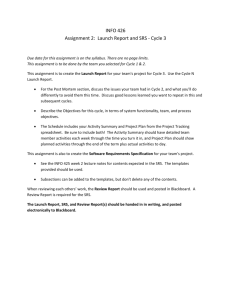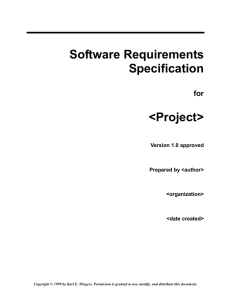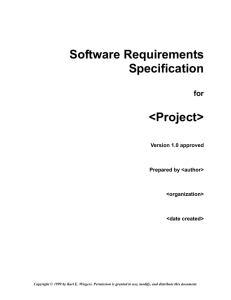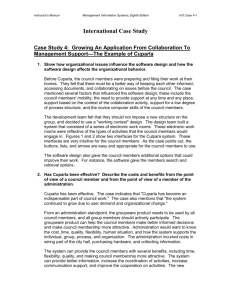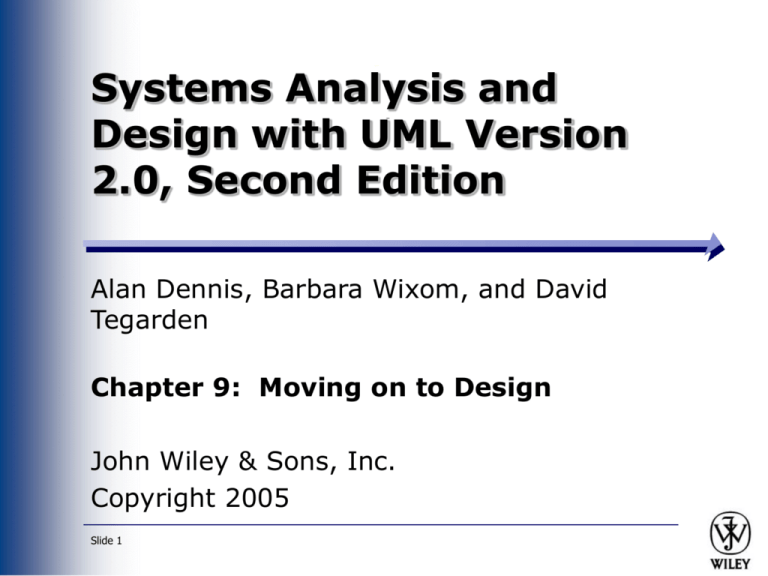
Systems Analysis and
Design with UML Version
2.0, Second Edition
Alan Dennis, Barbara Wixom, and David
Tegarden
Chapter 9: Moving on to Design
John Wiley & Sons, Inc.
Copyright 2005
Slide 1
Copyright © 2005
John Wiley & Sons, Inc.
All rights reserved. Reproduction or translation of this
work beyond that permitted in Section 117 of the 1976
United States Copyright Act without the express written
permission of the copyright owner is unlawful.
Request for further information should be addressed to
the Permissions Department, John Wiley & Sons, Inc.
The purchaser may make back-up copies for his/her own
use only and not for redistribution or resale.
The Publisher assumes no responsibility for errors,
omissions, or damages, caused by the use of these
programs or from the use of the information contained
herein.
Slide 2
Moving On To Design
Chapter 9 + Practical Suggestions
Slide 3
Key Ideas
The purpose of the analysis phase is
to figure out what the business
needs. The purpose of the design
phase is to figure out how to
provide it.
The steps in both analysis and
design phases are highly
interrelated and may require much
“going back and forth”
Slide 4
Avoid Classic Design
Mistakes
Reducing design time
Feature creep
Silver bullet syndrome
Switching tools in mid-project
Slide 5
What happens to the
components of the SRS
Use Cases
Classes
Interfaces
Data Dictionary
Slide 6
What happens to the
components of the SRS
Components
The initial components of the SRS
(use cases, classes, interfaces,
data dictionary items, and project
plan) are investigated, analyzed,
and further decomposed to yield a
more detailed descriptions of
these items for the SDS and
further deliverables.
Slide 7
What happens to the
components of the SRS
Use Cases Many additional items may be discovered
in design
Additional use cases may be identified that
reside inside original use cases Some may be
reusable in other use cases.
Additional steps may be identified requiring
additional classes, attributes, methods or
interfaces
Additional scenarios may be identified and
exception scenarios are more clearly defined.
Slide 8
What happens to the
components of the SRS
Classes Many additional classes, attributes and
methods may be discovered in design
Design Classes are identified which are new
to the class diagram. Our original class
diagram contained only domain classes.
Other types of classes are added here.
Additional class attributes, or class methods
for the original domain classes are added and
also for the new design classes.
Slide 9
What happens to the
components of the SRS
Interfaces Many additional interfaces and interface
fields may be discovered in design
Whole new interfaces may be discovered as a
result of portions of a user interface being
needed for more than one use case. Other
new interfaces are identified for various
reasons.
Additional interface fields may be identified
that were now known before this time.
Slide 10
What is the biggest change.
The use cases evolve and are certainly changed.
However the biggest change is the class
definitions. We will not only code the domain
classes but MANY other classes.
Lets take a look at what is referred to as the
Extended Class Diagram.
An extended class diagram is a class diagram
that is used by the use case. Typically you do
not draw the entire design class diagram but
rather limit its scope to the use case.
Slide 11
Extended Class Diagram
For each use case – add other
classes
1. Classes from the domain are
included
2. Classes for User Interfaces
3. Classes for use case control
4. Classes for the Database
5. Classes for Patterns (architectural,
design, and programming).
6. Classes for Frameworks.
Slide 12





